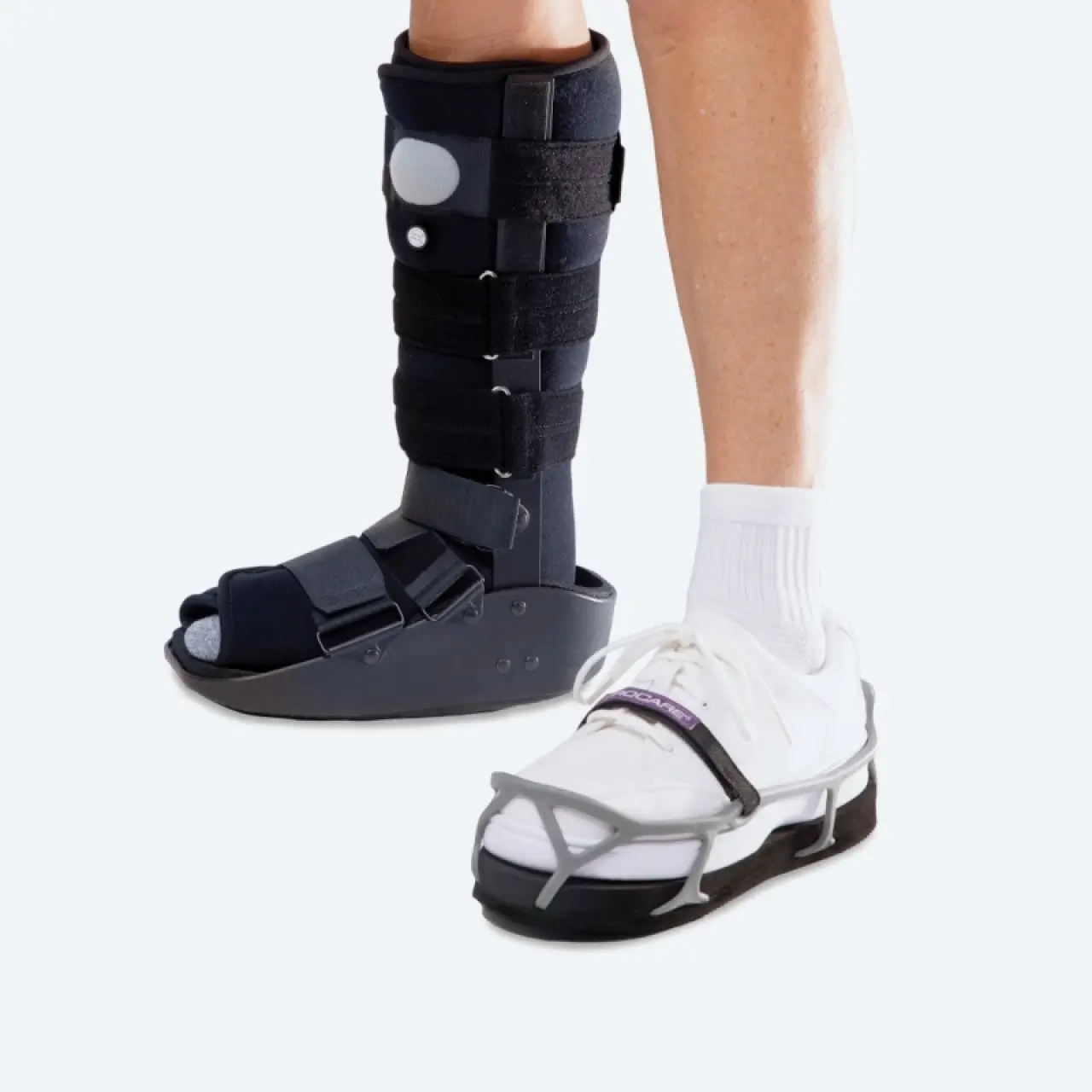
Rated 4.9 stars from 335+ reviews
We’re thrilled to announce receiving hundreds of five-star reviews! While we’d love to share these testimonials, regulations from the Australian Health Practitioner Regulation Agency (AHPRA) prevent us from displaying patient outcomes for regulated services such as Chiropractic, Physiotherapy, Osteopathy, Podiatry, and Acupuncture on this website. To read client feedback, please visit our Google Reviews directly.

Embarking on the journey of recovery from lower limb injuries requires not just time, but the right support and equipment to ensure a safe and efficient healing process.
Recover with confidence using our premium CAM walker boots, meticulously designed to accelerate your journey to wellness.
Professional fittings combine cutting-edge technology with ergonomic support, ensuring each step you take is cushioned, controlled, and conducive to healing. The Moon Boots and specialist crutches are tailored by your practitioner to maximise stability while minimising ankle and foot movement, promoting an efficient and comfortable recovery.
Discover the difference a precision fit makes and why healthcare professionals recommend CAM walkers as the superior choice for managing lower limb injuries. Book your personalised fitting today and embrace the path to recovery with unparalleled support.
Experience stability, flexibility, and comfort with premium CAM walker boots, designed to enhance your recovery process
Enhanced Stability: Offering a more stable base than plaster casts, our CAM boots significantly reduce the risk of trips and falls.
Removable Convenience: Easily removable for essential activities like showering and sleeping, their lightweight construction facilitates effortless leg movement.
Hygienic and Comfortable: The washable soft nylon/foam lining ensures cleanliness and comfort, even with extended use.
Achilles Recovery Support: Our Achilles wedge kits allow for gradual heel height adjustment, aiding in a phased recovery.
Extensive Variety: We stock a wide range of CAM boots, catering to all ages and needs, including options with pump air compression and varying boot tops for customised support.
For personalised advice on fitting and usage, consult with a trained health professional to ensure optimal recovery effectiveness and safety. While our front desk staff are available to assist with scheduling and general inquiries, expert guidance on CAM boots, including their fit and use, must come from a qualified health professional such as a Physio, Chiro, Osteo or Podiatrist.
This ensures the efficacy of your treatment and guarantees your safety and comfort during recovery. While our reception team is welcoming and helpful, their primary role is to facilitate your access to professional support, not to advise on CAM boot specifics or assist with fitting.
Pneumatic Air Pump & Release
Experience unparalleled support with our moon boot walkers, designed with innovative air pressure technology for optimal compression and comfort. Easily adjustable, they ensure a snug, stable fit that adapts to inflammatory changes for your ultimate convenience, support and relief.
Practitioners are dedicated to providing not just recovery tools but also the expertise and support to ensure their effective use. Your practitioner will guide you through every step of your healing process, emphasising safety, efficiency, and comfort. Schedule your moon boot fitting today and take a confident step towards recovery. With specialised knowledge, your injury will be properly stabilised, minimising unnecessary movement and reducing the risk of further complications, ensuring a smoother recovery path.
Considering a CAM boot for your recovery? We strongly recommend a consultation with your practitioner, whether you’re purchasing in-person or online.
This ensures the boot is perfectly tailored to your specific condition and provides you with essential insights for its optimal use, including important precautions like preventing Deep Vein Thrombosis (DVT).
While the convenience of online or over-the-counter purchases may seem appealing, without professional guidance, you risk suboptimal recovery or, worse, additional complications. Ensure a safer, more effective healing journey by consulting with a CAM boot specialist first.
Choosing a CAM walker is more than selecting a size—it’s about ensuring the perfect fit, type, and usage strategy tailored to your specific injury and stage of recovery.
Your practitioner is more than a fitter; they are a lower limb consultant with in-depth knowledge of conditions affecting the foot, ankle, knee, and hip. Working closely with renowned orthopaedic surgeons, your practitioner provides a holistic approach to post-operative care and rehabilitation.
Proper sizing is crucial. An oversized boot can cause tripping, while an undersized boot may lead to painful toe injuries and hinder your recovery.
Managing the imbalance caused by the CAM walker’s height is essential for maintaining a correct gait and preventing additional strain, particularly on the back.
A shoe lift for the non-affected leg can be beneficial for improving balance, but it should be tailored to individual comfort and monitored to ensure it doesn’t cause new discomfort.
Additionally, using crutches, particularly in the early stages of recovery, can significantly reduce pressure on the injured limb, enhancing both balance and mobility. Consult your practitioner to ensure the best approach for your specific needs.
It is highly advised against operating a vehicle while wearing a CAM walker, particularly on the foot used for braking or operating the clutch.
The boot restricts ankle movement, potentially delaying your reaction times and increasing the risk of accidents. If medically permissible, consider removing the CAM walker while driving to mitigate this risk.
Always consult a healthcare professional before making any adjustments to your CAM walker use when driving. Additionally, be mindful that driving with a CAM walker could potentially invalidate some insurance policies unless it is proven that all reasonable precautions were taken.
Extra caution is required when navigating stairs with a CAM boot due to limited ankle mobility.
When ascending, lead with the uninjured foot; when descending, lead with the injured foot—remember, “Up with the good, down with the bad.”
To enhance safety, keep your hands free by using a backpack for carrying items, use handrails wherever available, and consider having someone assist you from behind while you acclimate to the boot. Always prioritise safety to avoid additional strain or injury.
Maintaining a dry CAM boot is crucial to prevent moisture build-up, which can cause skin irritation and bacterial growth.
This is especially important for individuals with diabetes or those recovering from wounds or surgeries, as moisture can significantly increase the risk of infection.
Ensure the boot is covered and protected from water to preserve its integrity and safeguard your health.
Deep Vein Thrombosis (DVT) is a serious condition characterised by blood clots forming in the veins, commonly in the lower legs.
Symptoms include increased leg pain, throbbing or cramping in the calf, thigh, or groin, swelling or redness in the immobilised leg, and a warm sensation around the affected area.
Immediate medical consultation is crucial if any symptoms arise.
To reduce the risk of DVT when wearing a CAM boot:
If you experience symptoms of DVT, seek immediate medical attention.
Here’s a general guide on the steps for putting on and taking off a CAM boot:
Preparation: Ensure the boot is fully open, including all straps and fasteners.
Placement: Sit down and carefully place your foot into the boot, heel first, ensuring it sits snugly at the back.
Securing the Boot: Close the foam liner over your foot and leg. Begin fastening the straps from the bottom up 9start at the toes), adjusting each strap so it’s comfortably tight and supports your foot and ankle securely.
Fit Adjustment for CAM Boots: Once all straps are secured, inflate the air cells until the fit feels snug and comfortable.
Take a short walk to ensure the boot fits properly and remains securely in place without slipping. Adjust the tightness and air pressure as needed.
Additionally, keep an eye on circulation; ensure that your toes do not become cold or turn blue, which could indicate restricted blood flow. Adjust the fit if you notice any signs of impaired circulation.
Removal: To take off the boot, unfasten the straps from top to bottom and open the liner. Gently slide your foot out of the boot.
Make sure to follow any specific instructions provided by your healthcare provider for optimal safety and recovery.
Our clinic offers a HICAPS facility for on-the-spot insurance claims, potentially covering part of your consultation and possibly the CAM boot itself, leaving you to only pay the gap.
If you have private health insurance, please verify with your insurer what is covered under your policy. Due to privacy regulations, we are unable to provide specific insurance advice, so it’s important to check directly with your insurance provider.
When using a CAM boot, consider these essential accessories for optimal recovery.
Browse our general FAQ for quick answers.
Rehabilitation exercises should not begin until medically advised by your treating practitioner. Starting too early poses a serious risk of reaggravating or worsening your injury. Once medically cleared, the following are common exercises:
Ankle and Foot Range of Movement
Perform exercises such as pointing your foot up and down, moving your toes apart, and making circles with your foot. Repeat these exercises 10 times, 3-4 times a day.
Early Weight Bearing
Start putting weight on your injured foot as soon as it is comfortable. Begin by walking with your heel touching the ground first to minimise pressure on your toes.
Elevation and Cold Packs
Elevate your foot above the level of your hips to reduce swelling. Apply a cold pack wrapped in a damp towel to the sore area for up to 15 minutes, several times a day.
Pain Relief
Take painkillers as prescribed to manage pain effectively. If pain persists, consult your healthcare provider.
Walking Techniques
Walk with your heel touching the ground first to avoid putting too much pressure on your toes. This technique helps distribute weight more evenly and reduces strain on the injured area.
Footwear for the Uninjured Foot
Wear a supportive shoe or trainer with a firm sole on your uninjured foot. Matching the height of the CAM boot on the injured side helps reduce stress on your other joints.
If you are diabetic, it’s important to make an appointment with your health practitioner. This is particularly crucial if you have skin or circulation problems, as you may need a specialist diabetic boot.
Regular Check-Ups
Follow up with your healthcare provider if you experience significant pain and swelling after six weeks or if you have difficulty weaning off the boot.
Maintenance of the Boot
Regularly inspect the boot for wear and tear. Clean it as needed to maintain hygiene and functionality.
Transitioning Out of the Boot
Gradually reduce the use of the boot as advised by your healthcare provider. Start walking without the boot around your home before venturing outside.
Discover How We Can Get You Back on Track!
We are conveniently located in the heart of Brunswick for easy access to all local residents.
Address: 1/68 Melville Road Brunswick, VIC 3055
Areas We Serve
Brunswick, Brunswick West, Brunswick East, Essendon, Moonee Ponds, Parkville, Coburg, Carlton, Fitzroy, Pascoe Vale South, Pascoe Vale, Thornbury, Northcote.

